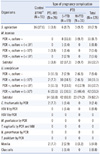1. McCormick MC. The contribution of low birth weight to infant mortality and childhood morbidity. N Engl J Med. 1985. 312:82–90.

2. Mathews TJ, MacDorman MF. Infant mortality statistics from the 2006 period linked birth/infant death data set. Natl Vital Stat Rep. 2010. 58:1–31.
3. Moutquin JM. Classification and heterogeneity of preterm birth. BJOG. 2003. 110(Suppl 20):30–33.

4. Pararas MV, Skevaki CL, Kafetzis DA. Preterm birth due to maternal infection: Causative pathogens and modes of prevention. Eur J Clin Microbiol Infect Dis. 2006. 25:562–569.

5. Gonçalves LF, Chaiworapongsa T, Romero R. Intrauterine infection and prematurity. Ment Retard Dev Disabil Res Rev. 2002. 8:3–13.

6. Romero R, Mazor M. Infection and preterm labor. Clin Obstet Gynecol. 1988. 31:553–584.

7. Gibbs RS, Romero R, Hillier SL, Eschenbach DA, Sweet RL. A review of premature birth and subclinical infection. Am J Obstet Gynecol. 1992. 166:1515–1528.

8. Hollier LM. Preventing preterm birth: what works, what doesn't. Obstet Gynecol Surv. 2005. 60:124–131.

9. Goldenberg RL, Hauth JC, Andrews WW. Intrauterine infection and preterm delivery. N Engl J Med. 2000. 342:1500–1507.

10. Uh Y, Choi SJ, Jang IH, Lee KS, Cho HM, Kwon O, et al. Colonization rate, serotypes, and distributions of macrolide-lincosamide-streptogramin B resistant types of group B streptococci in pregnant women. Korean J Clin Microbiol. 2009. 12:174–179.
11. Bayraktar MR, Ozerol IH, Gucluer N, Celik O. Prevalence and antibiotic susceptibility of Mycoplasma hominis and Ureaplasma urealyticum in pregnant women. Int J Infect Dis. 2010. 14:e90–e95.
12. Kim TH, Kim TH, Kim HR, Lee MK, Myung SC, Kim YS. Detection of cryptic microorganisms in patients with chronic prostatitis by multiplex polymerase chain reaction. Korean J Urol. 2007. 48:304–309.

13. Hay PE, Lamont RF, Taylor-Robinson D, Morgan DJ, Ison C, Pearson J. Abnormal bacterial colonisation of the genital tract and subsequent preterm delivery and late miscarriage. BMJ. 1994. 308:295–298.

14. Lee SE, Romero R, Kim EC, Yoon BH. A high Nugent score but not a positive culture for genital mycoplasmas is a risk factor for spontaneous preterm birth. J Matern Fetal Neonatal Med. 2009. 22:212–217.

15. Breugelmans M, Vancutsem E, Naessens A, Laubach M, Foulon W. Association of abnormal vaginal flora and Ureaplasma species as risk factors for preterm birth: a cohort study. Acta Obstet Gynecol Scand. 2010. 89:256–260.
16. Usui R, Ohkuchi A, Matsubara S, Izumi A, Watanabe T, Suzuki M, et al. Vaginal lactobacilli and preterm birth. J Perinat Med. 2002. 30:458–466.

17. Priestley CJ, Jones BM, Dhar J, Goodwin L. What is normal vaginal flora? Genitourin Med. 1997. 73:23–28.

18. Donati L, Di Vico A, Nucci M, Quagliozzi L, Spagnuolo T, Labianca A, et al. Vaginal microbial flora and outcome of pregnancy. Arch Gynecol Obstet. 2010. 281:589–600.

19. Yoon BH, Chang JW, Romero R. Isolation of Ureaplasma urealyticum from the amniotic cavity and adverse outcome in preterm labor. Obstet Gynecol. 1998. 92:77–82.
20. Edwards RK, Ferguson RJ, Reyes L, Brown M, Theriaque DW, Duff P. Assessing the relationship between preterm delivery and various microorganisms recovered from the lower genital tract. J Matern Fetal Neonatal Med. 2006. 19:357–363.

21. Taylor-Robinson D, Lamont RF. Mycoplasmas in pregnancy. BJOG. 2011. 118:164–174.

22. Romero R, Mazor M, Oyarzun E, Sirtori M, Wu YK, Hobbins JC. Is genital colonization with Mycoplasma hominis or Ureaplasma urealyticum associated with prematurity/low birth weight? Obstet Gynecol. 1989. 73:532–536.
23. Carey JC, Blackwelder WC, Nugent RP, Matteson MA, Rao AV, Eschenbach DA, et al. The vaginal infections and prematurity study group. Antepartum cultures for Ureaplasma urealyticum are not useful in predicting pregnancy outcome. Am J Obstet Gynecol. 1991. 164:728–733.
24. Ekiel AM, Friedek DA, Romanik MK, Jóźwiak J, Martirosian G. Occurrence of Ureaplasma parvum and Ureaplasma urealyticum in women with cervical dysplasia in Katowice, Poland. J Korean Med Sci. 2009. 24:1177–1181.
25. Kafetzis DA, Skevaki CL, Skouteri V, Gavrili S, Peppa K, Kostalos C, et al. Maternal genital colonization with Ureaplasma urealyticum promotes preterm delivery: association of the respiratory colonization of premature infants with chronic lung disease and increased mortality. Clin Infect Dis. 2004. 39:1113–1122.
26. Farley MM, Harvey RC, Stull T, Smith JD, Schuchat A, Wenger JD, et al. A population-based assessment of invasive disease due to group B streptococcus in nonpregnant adults. N Engl J Med. 1993. 328:1807–1811.

27. Garland SM, Kelly N, Ugoni AM. Is antenatal group B streptococcal carriage a predictor of adverse obstetric outcome? Infect Dis Obstet Gynecol. 2000. 8:138–142.

28. Goldenberg RL, Andrews WW, Yuan AC, MacKay HT, St Louis ME. Sexually transmitted diseases and adverse outcomes of pregnancy. Clin Perinatol. 1997. 24:23–41.

29. Eschenbach DA, Nugent RP, Rao AV, Cotch MF, Gibbs RS, Lipscomb KA, et al. A randomized placebo-controlled trial of erythromycin for the treatment of Ureaplasma urealyticum to prevent premature delivery. The vaginal infections and prematurity study group. Am J Obstet Gynecol. 1991. 164:734–742.






 PDF
PDF ePub
ePub Citation
Citation Print
Print


 XML Download
XML Download